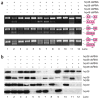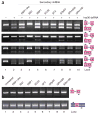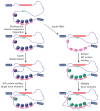A regulator of Dscam mutually exclusive splicing fidelity - PubMed (original) (raw)
A regulator of Dscam mutually exclusive splicing fidelity
Sara Olson et al. Nat Struct Mol Biol. 2007 Dec.
Abstract
The Down syndrome cell adhesion molecule (Dscam) gene has essential roles in neural wiring and pathogen recognition in Drosophila melanogaster. Dscam encodes 38,016 distinct isoforms via extensive alternative splicing. The 95 alternative exons in Dscam are organized into clusters that are spliced in a mutually exclusive manner. The exon 6 cluster contains 48 variable exons and uses a complex system of competing RNA structures to ensure that only one variable exon is included. Here we show that the heterogeneous nuclear ribonucleoprotein hrp36 acts specifically within, and throughout, the exon 6 cluster to prevent the inclusion of multiple exons. Moreover, hrp36 prevents serine/arginine-rich proteins from promoting the ectopic inclusion of multiple exon 6 variants. Thus, the fidelity of mutually exclusive splicing in the exon 6 cluster is governed by an intricate combination of alternative RNA structures and a globally acting splicing repressor.
Figures
Figure 1
hrp36 is required for mutually exclusive splicing fidelity in the exon 6 cluster of Dscam. (a) Organization of D. melanogaster Dscam. (b) S2 cells were incubated alone or in the presence of hrp36 or pasilla double-stranded RNA, and splicing of the exon 6 cluster was examined by RT-PCR using primers in exons 5 and 7. Below, western blot showing that hrp36 levels are reduced in cells treated with hrp36 double-stranded RNA and that depletion of hrp36 is specific, as the levels of hrp40/sqd are unchanged. (c) A higher resolution gel, cloning and sequencing revealed that the larger bands correspond to products derived from mRNAs containing multiple exon 6 variants.
Figure 2
hrp36 functions in a cluster-specific manner. (a–d) RT-PCR was used to examine the role of hrp36 in mutually exclusive splicing of the exon 4 (a), exon 6 (b), exon 9 (c) and exon 17 (d) clusters. These experiments revealed no impact of hrp36 depletion on mutually exclusive splicing of the exon 4, exon 9 or exon 17 clusters. In contrast, depletion of hrp36 results in the splicing of multiple adjacent exon 6 variants throughout the exon 6 cluster. The primers used in each experiment and the identity of the products, which were confirmed by cloning and sequencing, are depicted.
Figure 3
hrp36 is the only major hnRNP protein that regulates the fidelity of exon 6 mutually exclusive splicing. (a,b) D. melanogaster S2 cells were treated with hrp36, hrp38, hrp40 and hrp48 double-stranded RNAs as indicated. Exon 6 splicing was examined by RT-PCR with primers to detect the specified exons (a), and the extent and specificity of depletion was monitored by western blotting (b). Note that the hrp38 antibody cross-reacts with hrp36 to some extent.
Figure 4
hrp36 binds to exon 6 variants. Gel mobility shift experiments show that exons 6.47 (left) and 6.48 (right) bind to recombinant hrp36. However, mutations that disrupt the putative hrp36 binding sites eliminate the protein-RNA interaction.
Figure 5
hrp36 binds to Dscam pre-mRNA throughout the entire exon 6 cluster. The distribution of the RNA sequences bound by hrp36, hrp38, hrp40 and hrp48 across the Dscam gene are shown. These maps were determined by labeling and hybridizing RNAs that coimmunoprecipitate with antibodies specific to each hnRNP protein to genome-wide Drosophila tiling arrays.
Figure 6
hrp36 prevents ectopic exon 6 inclusion by SR proteins. To test whether the effect of depleting hrp36 could be reversed by co-depleting various SR proteins, S2 cells were treated with double-stranded RNAs to hrp36 and/or the indicated SR proteins. (a) The inclusion of multiple exon 6 variants induced by depletion of hrp36 can be reversed to various extents by co-depleting different SR proteins. (b) Depletion of the SR proteins alone has no effect on exon 6 mutually exclusive splicing in the presence of hrp36.
Figure 7
Model for the mechanism by which hrp36 prevents the inclusion of multiple exon 6 variants. hrp36 (blue circles) binds to all of the exon 6 variants (magenta) and represses their inclusion. When the selector sequence upstream of a specific exon interacts with the docking site, this results in the de-repression of hrp36 on the exon immediately downstream, but not for the other exon 6 variants. In this way, only a single exon 6 variant is included. hrp36 competes with SR proteins (green circles) for binding to the exon 6 variants. In the absence of hrp36, these activators could bind to all of the exon 6 variants and enhance their splicing to one another.
Similar articles
- Srrm234, but not canonical SR and hnRNP proteins, drive inclusion of Dscam exon 9 variable exons.
Ustaoglu P, Haussmann IU, Liao H, Torres-Mendez A, Arnold R, Irimia M, Soller M. Ustaoglu P, et al. RNA. 2019 Oct;25(10):1353-1365. doi: 10.1261/rna.071316.119. Epub 2019 Jul 10. RNA. 2019. PMID: 31292260 Free PMC article. - Competing RNA secondary structures are required for mutually exclusive splicing of the Dscam exon 6 cluster.
May GE, Olson S, McManus CJ, Graveley BR. May GE, et al. RNA. 2011 Feb;17(2):222-9. doi: 10.1261/rna.2521311. Epub 2010 Dec 15. RNA. 2011. PMID: 21159795 Free PMC article. - Regulation of Dscam exon 17 alternative splicing by steric hindrance in combination with RNA secondary structures.
Yue Y, Li G, Yang Y, Zhang W, Pan H, Chen R, Shi F, Jin Y. Yue Y, et al. RNA Biol. 2013 Dec;10(12):1822-33. doi: 10.4161/rna.27176. Epub 2013 Nov 21. RNA Biol. 2013. PMID: 24448213 Free PMC article. - Alternative splicing--when two's a crowd.
Smith CW. Smith CW. Cell. 2005 Oct 7;123(1):1-3. doi: 10.1016/j.cell.2005.09.010. Cell. 2005. PMID: 16213205 Review. - Mechanisms of Drosophila Dscam mutually exclusive splicing regulation.
Hemani Y, Soller M. Hemani Y, et al. Biochem Soc Trans. 2012 Aug;40(4):804-9. doi: 10.1042/BST20120060. Biochem Soc Trans. 2012. PMID: 22817738 Review.
Cited by
- Functional impact of splice isoform diversity in individual cells.
Yap K, Makeyev EV. Yap K, et al. Biochem Soc Trans. 2016 Aug 15;44(4):1079-85. doi: 10.1042/BST20160103. Biochem Soc Trans. 2016. PMID: 27528755 Free PMC article. Review. - Cooperation and Competition of RNA Secondary Structure and RNA-Protein Interactions in the Regulation of Alternative Splicing.
Vorobeva MA, Skvortsov DA, Pervouchine DD. Vorobeva MA, et al. Acta Naturae. 2023 Oct-Dec;15(4):23-31. doi: 10.32607/actanaturae.26826. Acta Naturae. 2023. PMID: 38234601 Free PMC article. - Control of alternative splicing by signal-dependent degradation of splicing-regulatory proteins.
Katzenberger RJ, Marengo MS, Wassarman DA. Katzenberger RJ, et al. J Biol Chem. 2009 Apr 17;284(16):10737-46. doi: 10.1074/jbc.M809506200. Epub 2009 Feb 13. J Biol Chem. 2009. PMID: 19218244 Free PMC article. - Predicted networks of protein-protein interactions in Stegodyphus mimosarum by cross-species comparisons.
Wang X, Jin Y. Wang X, et al. BMC Genomics. 2017 Sep 11;18(1):716. doi: 10.1186/s12864-017-4085-8. BMC Genomics. 2017. PMID: 28893204 Free PMC article. - Ultra-deep profiling of alternatively spliced Drosophila Dscam isoforms by circularization-assisted multi-segment sequencing.
Sun W, You X, Gogol-Döring A, He H, Kise Y, Sohn M, Chen T, Klebes A, Schmucker D, Chen W. Sun W, et al. EMBO J. 2013 Jul 17;32(14):2029-38. doi: 10.1038/emboj.2013.144. Epub 2013 Jun 21. EMBO J. 2013. PMID: 23792425 Free PMC article.
References
- Blencowe BJ. Alternative splicing: new insights from global analyses. Cell. 2006;126:37–47. - PubMed
- Xing Y, Lee C. Alternative splicing and RNA selection pressure–evolutionary consequences for eukaryotic genomes. Nat Rev Genet. 2006;7:499–509. - PubMed
- Black DL. Protein diversity from alternative splicing: a challenge for bioinformatics and post-genome biology. Cell. 2000;103:367–370. - PubMed
- Graveley BR. Alternative splicing: increasing diversity in the proteomic world. Trends Genet. 2001;17:100–107. - PubMed
- Schmucker D, et al. Drosophila Dscam is an axon guidance receptor exhibiting extraordinary molecular diversity. Cell. 2000;101:671–684. - PubMed
Publication types
MeSH terms
Substances
Grants and funding
- GM67842/GM/NIGMS NIH HHS/United States
- R01 GM062516/GM/NIGMS NIH HHS/United States
- GM62561/GM/NIGMS NIH HHS/United States
- R01 GM067842/GM/NIGMS NIH HHS/United States
- GM61987/GM/NIGMS NIH HHS/United States
- R01 GM061987/GM/NIGMS NIH HHS/United States
- R01 GM062516-07/GM/NIGMS NIH HHS/United States
- R01 GM067842-06/GM/NIGMS NIH HHS/United States
LinkOut - more resources
Full Text Sources
Molecular Biology Databases






